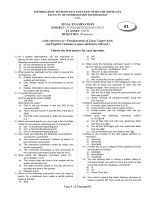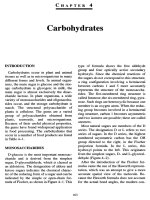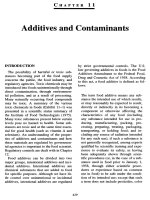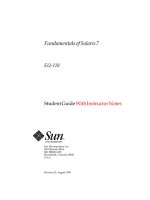Lect 1 fundamentals of chemistry
Bạn đang xem bản rút gọn của tài liệu. Xem và tải ngay bản đầy đủ của tài liệu tại đây (266.7 KB, 23 trang )
Fundamentals of Chemistry
Chem 1102 Aspects of Chemistry
Fall 2008
Chemistry
• The Central Science
– The study of matter
– Explains every aspect of daily life
– Is essential to understand nearly all scientific,
medical and pharmaceutical disciplines, and
engineering
• A Qualitative Science
– Chemistry is based in experimental
observation
Chemistry
• A Quantitative Science
– We want to know how many, how much, how
good is the measurement
• An Experimental Science
• A Method of Inquiry
– Based on the Scientific Method
– An intellectual pursuit
– To probe the world around us
Scientific Method
• Identify a question
• Propose a hypothesis
• Construct and carry out experiment to test
hypothesis
• Observe and record results
• Refine hypothesis
• Test refined hypothesis with more expts (repeat
as needed)
• Develop theory that is consistent with
observations and accepted laws of nature and
predicts future exptal outcomes
Chemistry in Daily Life
• Health care including diagnostics,
treatment, medicine, prevention (p. 1, 17,
18, 78, 102, 113, 118, 128, 166, 172, 178, 208,
226)
• Food (p. 2, 5, 7, 11, 13, 21, 29, 36, 52, 66, 83,
84, 100, 116, 118, 175, 197, 199, 205
• Environment (p. 46, 50, 105, 107, 122, 145,
180, 195)
• Materials around the house (all the rest)
Chemistry
• Chemistry is the study of matter
– Matter has mass and volume
– Matter has physical properties
– Matter has chemical properties
– There are 3 states of matter
• And how matter changes
– Life of the cell
– Production and decay of material
– Combustion of fuels
Figure 1.16
Organization
of Matter
(Zumdahl)
Atomic Theory of Matter (1808)
• John Dalton (1766-1844)
• Elements (matter) are composed of atoms
• The atoms of a given element are
identical. Each element is characterized
by the mass of its atoms.
• Compounds are formed when atoms of
different elements combine with each
other.
Atomic Theory of Matter (2)
• A given compound is a chemical
combination of the same atoms in the
same relative numbers.
• A chemical reaction is the rearrangement
of atoms leading to new compounds.
Atoms are neither destroyed nor created in
a chemical reaction (Conservation of
Mass).
• />s/1911.html
A Deeper Look into the Atom
Particle
Mass (kg)
Charg Discoverer
e
Electron, e- 9.11E-31
-1
J.J. Thomson
Proton, p+
+1
E. Rutherford
0
Chadwick
1.67E-27
Neutron, n0 1.67E-27
Other
Figure 2.13 (Zumdahl) (a) Expected Results
of the Metal Foil Experiment if Thomson's
Model Were Correct (b) Actual Results
More on the Atom
• An atom is uniquely defined by #p+ = Z = atomic
number (see Periodic Table)
• In a neutral atom, #p+ = #e-; note that #n is not
equal to #p+ nor #e-.
• In an atomic ion, #p+ ≠ #e- resulting in a net
nonzero charge on the species
– Neutral atoms can lose electrons producing a positive
ion or cation because #p+ > #e– Or gain electrons - ion or anion because #p+ < #e-
Isotope
• Atoms which have the same Z (same # p+)
but a different A (different # n0)
• Most elements have isotopes that occur in
nature in precise proportions (fractional
abundances, %).
• A few elements have no naturally
occurring isotopes.
Figure 2.21 The Periodic Table
Periodic Table
• An arrangement of elements according to
increasing atomic number (Z) which shows
the periodic or regularly repeating nature
of elemental properties.
– Rows = periods
– Columns = groups or families
– Metals, Nonmetals, Semimetals
– Main group (A), Transition Metals,
Lanthanides and Actinides
• />• />• />
On to Molecules (n x 10 )
6
• Molecules form when atoms are
connected by chemical bonds in which
electrons act as the “glue” between atoms.
• A compound has more than one type of
atom bonded together.
Chemical Bond Types
• IONIC: metal + nonmetal
– Electrons are transferred from metal to
nonmetal thus creating a cation (+) and anion
(-) which attract each other
• COVALENT: nonmetal + nonmetal
– Electrons are shared by both atoms
• METALLIC: metal + metal
Chemical Formula
• Shorthand symbol for cmps
• Qualitative description of the constituent
elements in a molecule or ion.
– C12H22O11 contains C, H and O
• Quantitative description of the relative
numbers (subscripts) of atoms of each
element.
– One molecule of sucrose has 12-C, 22-H and
11-O
Chemical Reaction
• A chemical rxn is a rearrangement of
atoms in which reactant compounds are
converted into product compounds.
• During a chem rxn, chemical bonds in the
reactants are broken and chemical bonds
in the products are created.
• A rxn is accompanied by a change in
energy (i.e. heat can be absorbed or given
off), color, state of matter, etc.
Chemical Equation
• Shorthand symbolic notation for a chemical
reaction
– CH4(g) + O2 (g) H2O(ℓ) + CO2(g)
– Note that this reaction is NOT BALANCED
• Qualitative aspect
– identity of reactants [R] and products [P]; use study of
nomenclature to write equations
– Identify the state of matter for each [R] and [P]
– identify reaction type
Chemical Equation (2)
• Quantitative aspect
– how much reactant is consumed and how
much product is formed
– coefficients must be consistent with the Law
of Conservation of Mass; atoms are neither
created nor destroyed in a chemical reaction.
– i.e. chemical equation must be balanced
• CH4(g) + 2O2 (g) 2H2O(ℓ) + CO2(g)
Note that this reaction is BALANCED









